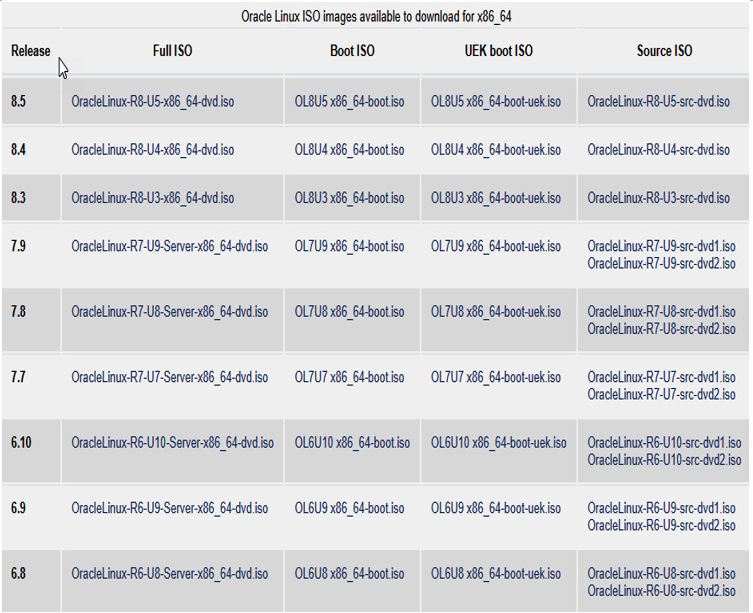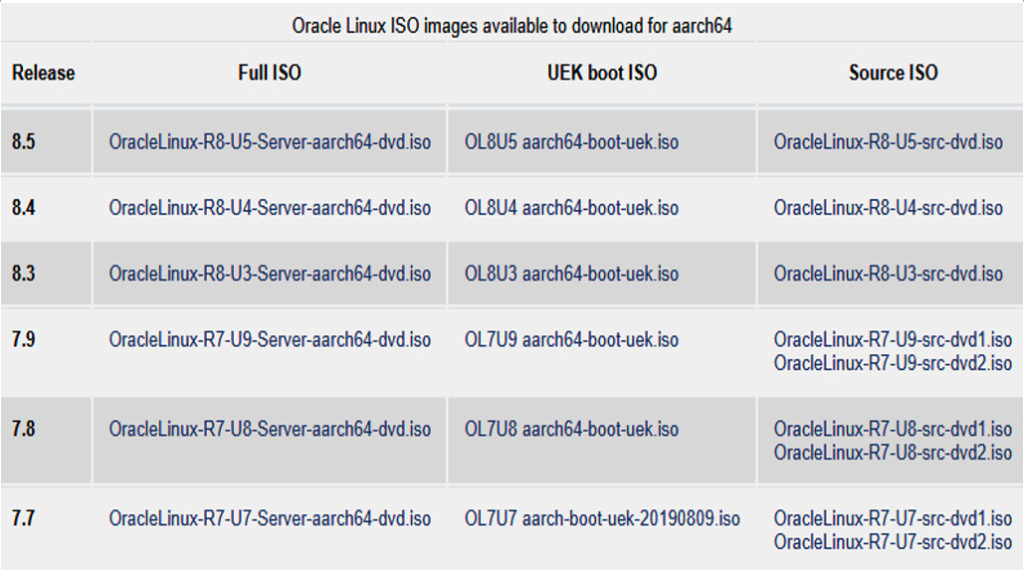Note
With both boot ISO options, the media must be available on the network on an FTP server, an HTTP/HTTPS server, or an NFS server.
Additionally, there are two CPU families available. Make sure you pick the correct architecture for the installation. Let’s look at what they are:
- x86_64: This is the most common architecture and is used on most Intel and AMD systems. This includes Intel X-series processors and the i9, i7, i5, and i3 processors. For AMD systems, this includes the AMD EPYC processors, Ryzen processors, and the Athlon line. This is the most common option, but it’s being challenged in the industry by the Arm option. The full list of options from the download site for x86 can be seen in the following figure:

Figure 1.1 – x86_64 ISOs
- AArch64: This is what you need when using Oracle Linux on Arm servers, such as Raspberry Pi, or Ampere’s high-performance cloud-native processor CPUs. A cloud-native processor is a term for a CPU specifically designed for running cloud-native applications, optimized for lower power consumption with a more scalable architecture.
Running Oracle Linux on Arm is a very interesting option, as the application building blocks such as Java, Apache, Python, and Podman run using the same software versions that the x86 architectures use. All of these building blocks run almost identically to how they do on the x86 architecture, making the switch to Arm using Oracle Linux really easy for the applications. The advantage of Arm is it runs at a lower cost and higher density, offering a very attractive cost/performance story, enabling organizations to easily lower costs while improving performance. The currently available matrix of options for downloading Arm ISOs from the download site can be found in the following figure:

Figure 1.2 – Arm ISOs
Once we understand the platform, we also need to make another decision as to what version to use. Sometimes you may be able to download older versions and you may want to verify that the release will be supported. At the time of writing, while release 6 can be downloaded, support is available if you have purchased Extended Support, which is only available until June 2024.
Note
Extended Support from Oracle allows you to pay a fee in order to get support, including patches and fixes for critical security issues and select high-impact critical bugs. This support does not cover all RPMs. Given this, you may want to reconsider downloading and using older versions of Linux and avoid delaying upgrading the OS past the point of it being generally available. The value of Extended Support is that it can give you additional time to upgrade applications that require older versions of Oracle Linux.
Before you pick a release, check with your application team to verify the version is supported. There are differences between the major number (7 versus 8, etc.) and some software may not be available on all major release numbers. An example is Oracle Linux Automation Manager (this gives you centralized Ansible control, based on the AWX project, and is almost identical to Ansible Tower from Red Hat), which requires Oracle Linux 8. Another example is Oracle Linux Manager (aka Spacewalk), which requires Oracle Linux 7 for the server.
Note
Since Oracle Linux tracks Red Hat Enterprise Linux, the major and minor numbers are identical. Oracle Linux 7.10 is the same as Red Hat Enterprise Linux 7.10.